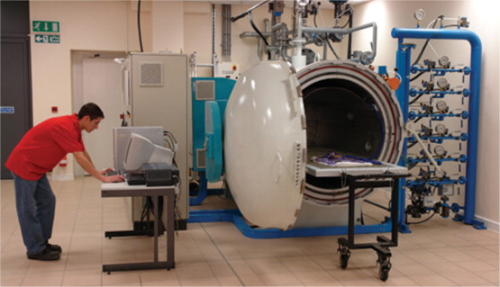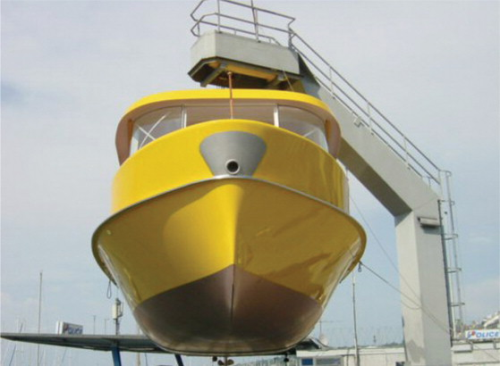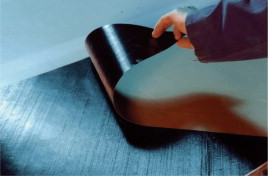



Composites have been a mainstay material of the boat building industry for probably 50 years. During that time polyester resins have given way to vinyl esters, and wet lay-up to infusion, but boat building has always been viewed as the ‘low tech’ end of composite processing. In aerospace and performance sectors the prepreg has always been king. Cost may be a limiting factor on their growth within the marine sector but in performance boat building they are now commonplace and the benefits are now also being realised in production yards where selective use of these ‘high tech’ materials can show real performance benefits.
What is a prepreg
Basically, a prepreg consists of a fibre reinforcement (carbon, glass, etc.) in unidirectional (aligned) or fabric (woven or multiaxial) form, impregnated to a pre-determined level with a resin matrix. The resin system will usually be an epoxy offering a broad range of properties. In aerospace and motor sport applications other higher performance resins may be used and prepregs do exist based on polyester and vinyl ester systems. Stringent control of resin content and dispersion eliminates the risk of fibre fraction variation and resin-rich areas, which ultimately control laminate performance, problems which can plague processes such as wet lay-up and vacuum infusion reducing laminate performance and adding weight.
Another benefit offered by prepregs is that all formulation and mixing is carried out under controlled conditions with no further handling of potentially harmful chemicals or exposure to volatile organic compounds (VOCs) such as styrene. Resin type, content and dispersion within the reinforcement can also be fine tuned to suit specific process requirements. So, what you get is a fully compounded reactive system, ready to laminate, possibly even custom formatted to meet the requirements of a particular project.
The process of laminating prepreg has been compared to upholstering. The impregnated reinforcement has soft, leather like texture and can be draped and formed around quite complex shapes. The inherent prepreg ‘tack’ allows accurate positioning of the reinforcement on a mould giving a high level of fibre orientation control and no risk of fibre movement or 'wash out' during cure. Laminate thickness can be built up quickly and whilst there are limits as a result of potential exotherm during cure, with suitable management laminates of more than 50 mm thick can be safely cured in one operation.
Core materials can be introduced and these are bonded using an adhesive in film form (prepreg glue).
Once completed, the laminate requires a combination of pressure and heat to consolidate the layers and initiate the resin curing reaction. Initial pressure is usually applied by placing an air tight membrane over the laminate and drawing vacuum. The component would then be placed in a high temperature autoclave – basically a large pressurised oven.
Typical curing conditions would be 120°C at a pressure of 3-7 atmospheres (bar) for 1-3 hours.
While the autoclave route remains the ultimate route for high performance components, it has be seen, because of the high costs and complexity, as a barrier to the wider adoption and application of high performance composite materials in other industries.
Step ahead curing
Innovative resin chemistry has always been at the heart of ACG's technology. Whilst it has always manufactured ‘standard’ 120°C and 180°C curing prepregs, a development known as ‘step ahead’ curing had, in the early 1980s, led to a breakthrough in prepreg technology. Low temperature moulding (LTM®) resins formulated to cure at low temperature (room temperature upwards) but then transformed by a further post cure treatment into highly robust structures. The 'step ahead' effect develops a state of cure exhibiting a much higher level of performance in terms of mechanical and thermal characteristics than would be expected from a particular curing condition. This enhanced stability allows the initial cure to take place at low temperature on relatively inexpensive tooling. The cure can then continue with the part out of the mould, stability still running ahead of the cure and therefore with no risk of distortion.
This concept was first exploited in LTM tooling prepregs. These resins exhibit resistance to the extremely high temperatures of curing cycles, but being inherently brittle were unsuitable for structural applications. They were also only suitable for autoclave processing. Continued development introduced toughness and low pressure (vacuum bag only) processing, essential characteristics that now made prepreg technology a reality for the marine industry.
That's not to say these materials were not without their handling difficulties. Prepreg must always be stored frozen to maximise life, but the reactivity of a particular prepreg system and its minimum curing temperature are closely linked. Low temperature curing means a particular material may only have a workshop working life of only a few days. Some early projects did show that these materials were attractive to the marine industry and were used on a number of one-off high performance race boat projects. LTM systems have even found their way into high-profile aerospace projects including Spaceship One and Global Flyer.
The marine environment
It was obvious that to be more attractive to the marine industry there was a need for more ‘user friendly’ prepreg formats –resins which retain the low temperature, low pressure moulding characteristics but are more flexible and forgiving in their handling to better suit the boatyard environment. The Variable Temperature Moulding (VTM®) system, with basic chemistry derived from the LTM system, offers flexible cure temperatures from a modest 65°C up to 120°C, a working life of 1 month, ‘step ahead’ cure, and will process without resorting to an autoclave.
The 2003 America's Cup proved to be a vital test bed for this new technology. Alinghi, a new European challenger, worked closely with ACG and winner SUI 64 became the first major success for the VTM system. Further successes and probably a greater test of the product's durability came with the build of the race-winning ABN AMRO Volvo 70 Round the World Race boats.
The VTM range has now grown into a family of structural, tooling, surfacing and gel-coat systems, offering the marine industry high performance and surface quality via a low cost processing route.
Despite the VTM system now being widely established in the marine industry, development continues. Composite materials are not cheap, but in the production environment the material/labour cost balance can be even more critical. Process innovations such as ZPREG® partial impregnation technology, where multi-layers of reinforcement are formatted together in a form that can be rapidly laminated, plus a supporting range of adhesives and gel-coats, have further enhanced the usability of these products, and prepreg components are now making significant inroads into the sailing and powerboat markets.
Prepregs are also being used extensively by the mast making industry. Many use standard 120°C curing systems and an autoclave (up to 40 m long). In the America's Cup there may even be crossover from Formula 1 motor racing in terms of the technology adopted, but other techniques such as vacuum bag and mandrel wrapping are often also used. In its most simple form, ‘towpreg' (a single strand of pre-impregnated carbon) can be spiral wound onto a mandrel to create a laminated structure.
What next?
Prepregs are now exploited throughout the marine industry and offer a cost-effective high performance route to composite construction, from America's Cup winners to production power boats. Experience gained working with the premier boat builders in the world has highlighted how ACG's resins can be further improved. Next generation prepreg matrix systems will offer further improvements in workshop handling, reduced temperature sensitivity and controlled tack levels, with optimised flow profiles to improve fibre wet out, reduce void levels improving laminate quality, and also allow the impregnation of much heavier reinforcement fabrics, opening further opportunities for the wider application of this versatile material form in the marine industry.





